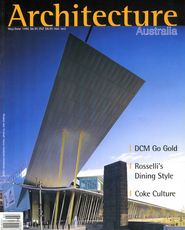Storey Hall Omission
I am writing with reference to the Storey Hall article in the January/February edition of Architecture Australia, in which artwork of mine is reproduced without acknowledgement.
Although permission was asked and given, I did stipulate that the use of any photograph depicting my work be credited to me. This omission represents a breach of trust, but more importantly, it misrepresents the work as a mere adjunct or extension to the architecture. The art work is not superficial decoration and should not be viewed as such. Therefore I am requesting that you rectify this problem in your next edition, buy offering an apology or reprinting the image appropriately credited.
From Jan Murray, St Kilda, Victoria
We apologise for this oversight–Ed.
National Log of Claims
Michael Peck referred in AA September/October to the ever-increasing “unruly behaviour of practitioners” in fee bidding and undercutting of each other. He and the APEA are proponents of the adoption by clients of the quality-based selection process; but convincing the profession to change its spots is an uphill battle.
Unfortunately, this “unruly behaviour” to obtain work at the expense of colleagues will always be the criteria which some practitioners will place above their ethical professional standards. This is especially so when our Institute does not enforce its Code of Professional Conduct. All members have a responsibility to uphold the Conditions of Engagement and Recommended Minimum Scale of Charges and the Institute’s Regulations and Bylaws Article 52 has provisions for reprimand or expulsion of any member whose conduct is contrary to this Code.
The CEO’s plea for compliance to proper professional conduct ignores the roots of the problem. How can we engender a quality base for clients to select from when we are constantly minimising our service to equate to reduced fees? Also, how can architects on below-average incomes afford an RAIA professional development scheme which is necessary to develop quality performance?
In lieu of qualified staff, practitioners are employing juniors and non-architect CAD operators to document and manage projects— cutting overheads but also sacrificing quality and expertise. Clients generally are unaware of the risks being taken at their expense. And as salaries and service quality continue to be depressed, the risks increase of professional negligence claims from clients.
The solutions, in the view of employee architects, are to:
-
Embody a requirement in all architect/client agreements that a qualified architect will be appointed to superintend every project for its full duration, and
-
Initiate compulsory minimum fees on par with industrial awards for equivalent professions’ responsibility levels, below which no employer may squeeze their overheads in low fee bidding.
If all practitioners are obliged to appoint competent project staff and pay reasonable common minimum staff remuneration, then the fee bidding process should be more equitable.
Our united aim must be for all architectural service selection to be resolved by client evaluation of quality, competency, efficiency and past performance, and with the understanding that these attributes come at a cost commensurate with the service expected.
To that end, the Architects Branch of the Association of Professional Engineers, Scientists and Managers (APESMA) has served a national log of claims on all employers of architects (except in Victoria) with a view to establishing a federal award for architects, graduates and students employed in the private sector. When established nationally, this will serve to raise the standing of employee architects to the benefit of the profession in general.
From John D. Sale, Architects Branch of APESMA, Melbourne
Narrow Perspective on UWA
In the second half of 1995, stories surfaced that the WA Architects Board was refusing to agree to a full five-year accreditation for the University of Western Australia architecture degree for a variety of reasons. An article, with an apparently narrow perspective, was included in the WA section of Radar in the September/October 1995 issue of Architecture Australia.
While this is a WA Board/UWA issue, it is of vital concern to the WA profession generally, and I believe a full explanation of the issue and of its apparent resolution, should be given to members. It is appropriate that RADAR should provide this explanation, hopefully from a broader perspective than its Sept/Oct 1995 coverage.
From Marcus Collins, Perth
AA contacted all of the key people involved in this dispute (representing AACA, the RAIA, the university and the board) but was given no publishable information of the rationale behind the board’s decision. Board chairman John Koivisto told us that it had no responsibility to explain to the profession why it was not accrediting the UWA course: “our responsibility is simply to administer the Architects Act in WA“. Our understanding, from sources outside the board who refuse to comment publicly, is that some board members disagreed with what they considered to be an emphasis on design over construction studies in the course and an under-representation of women on the teaching staff. Our sources also indicated that the board did not know of the lack of precedent, nor anticipate a controversy, over its rejection of the national visiting panel’s recommendation to accredit—Ed.
Thanks
I would like to thank the staff of Architecture Australia for their generosity in publishing the letter ‘Advertising Brochure Gone Mad’ (AA Jan/Feb 96).
Diane Kell, Editor Constructional Review, Sydney
Roles of the RAIA
Maurice Evans has suggested I respond to two questions:
-
Does our name, the Royal Australian Institute of Architects, reflect our desired image?
-
Can the RAIA truly represent all members of the profession?
My simple answer to both is yes. On the first question, a recent RAIA survey indicates that most members do not currently favour a name change to delete the word ‘Royal’. On the second the RAIA should and does attempt to serve all kinds of architects, no matter where they reside, on matters such as practice, education, professional development, disciplinary issues and negotiations with government and industry. But for obvious reasons, it cannot take sides on industrial disputes between different sections of the profession–such as the current notice of demand to many employers from APESMA on behalf of employee architects.
From Peter Gargett, RAIA National Past President, Brisbane
That’s My Institute
It’s true that this isn’t about what I read,
but rather about something I heard said.
And not the topic, though important that might be,
but rather, its the hearing that I can’t take lightly.
I heard our Institute’s name come from the TV
and in the context of electoral debate, you see.
Confused, but gratified, I analysed possibilities:
could this be the beginning of a new credibility?
or was it just the star quality of Mr Peck?
or did they put him on just, for the heck?
Then I saw that I was missing the issue of persuasion.
Analysis and options have no place in this occasion.
It came to me that confusion has the power to be great,
whenever it has gratification as its running mate.
It just felt so good then to be able to say,
“Yes, that’s my Institute they’re interviewing today”.
With apologies to Mr Peck for not giving priority to his issue of the value, within the environmental debate, of the so often overlooked built environment.
From John Parnell, Yerong, Queensland.
Low Standards of Review
Some architectural magazines are good. Others offer excuses. In the case of Architecture Australia, not even the excuses are credible.
I returned to Australia last December to find that my monograph Sydney Opera House, published by Phaidon Press, London, in mid-September, had not been reviewed in Architecture Australiabecause, as it was stated to me by the editor, it had already been widely reviewed and it was by then too late to do anything. On checking, I found only one genuine review in AA’s rival publicationMonument. I also noticed that the February 1996 issue carried a review by Adrian Snodgrass of a book first published as long ago as 1978! This hardly tallied with AA’s promise that it would “not slip back into its earlier habit of being slow to report to readers” and was inconsistent to say the very least.
I hate complaining but I find myself placed in an invidious position by this inept treatment of an important book, the first to date to examine the architectural design of the Sydney Opera House, and the first to publish a comprehensive set of drawings of the building; neither of which was easy. This is a subject which AA should surely have insisted on reviewing, not in the usual sloppy fashion of reviewing the author rather than the book, as happened to my previous offering,The Coast Dwellers, published by Penguin Australia. All the more so on this occasion, since the Sydney Opera House is currently the subject of a joint World Heritage nomination to UNESCO in Paris by the federal and NSW state governments. If successful, it will be a world first for a 20th century modern building. I wonder why, if The Architect’s Journal can manage to publish a book review that is fair as well as critical, AA can’t even make it off the starting block.
Low standards in book reviewing practice are regrettably prevalent, since many writers and that includes many academics, approach reviewing as an opportunity to slander the person of the author or settle scores instead of grappling with the intellectual matter of the writing; but your failure to even review Sydney Opera House sets an all-time new low in terms of editorial ineptness.
From Philip Drew, Sydney
Advance notice of this book would have been appreciated. Other journals were alerted; we were overlooked this time—an instance of “inept treatment” if publicity in AA was desired. —Ed.
Bestow Good Manners on Job-Seekers
It’s a common complaint of the young that job-seeking is very dispiriting because of the off-handedness (not to say rudeness) of prospective employers. As one who has been looking for work for several months at management level, I can say that the same applies to older job seekers. Not only do Sydney architects not acknowledge applications, but they do not even bother to notify interviewees of the outcome.
So—in recognition of my recent experiences—I bestow the following trophies:
- The Golden Handshake Award to the executive placement agencies who all reply gracefully and encouragingly to every applicant, successful or not. Thank you.
- The ???? Award to the large North Sydney practice which claims to be entering a new, dynamic phase and took a month to compiole an interview list, and another two months to make a choice. The mind boggles.
- The Raspberry Award to the Clarence Street practice where, on arriving punctually for an interview, I was told by reception “E. has gone out for a bit, I’ll leave a note on her desk.”. May all your clients be procrastinators.
A warm thank you to those practicers who behave in a polite and civilised manner. I know you’re out there, even though I haven’t met you yet.
And to all practices, a word of advice:
Remember that public relations applies not just to the clients that you know currently, but extends to the relatives and friends of those clients that you don’t know yet.
Word of mouth can be very negative.
Name withheld, Sydney
We welcome your concise views on issues of interest to architects. Please provide fax and phone numbers—we may need to edit. Only letters to the editor, not copies of letters to others, will be published. The RAIA’s chief executive officer has right of reply to criticism of the Institute.















